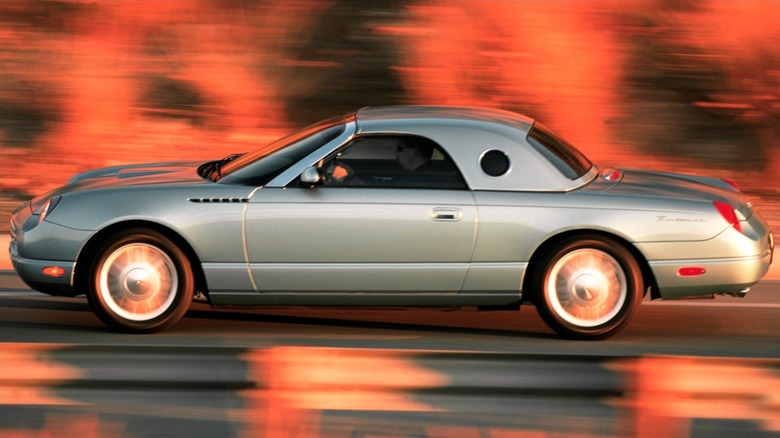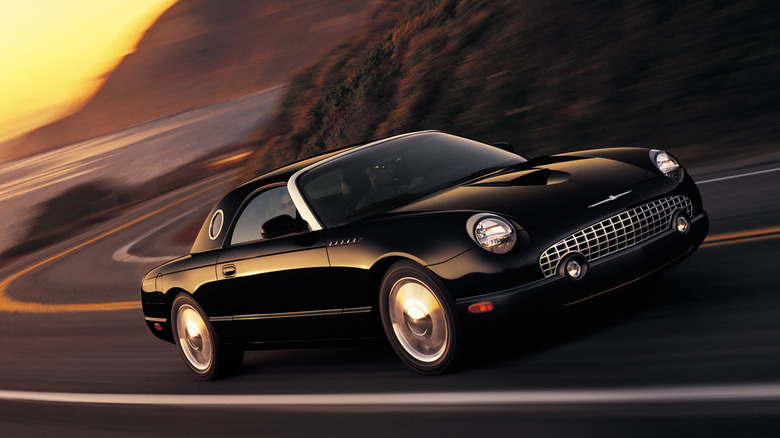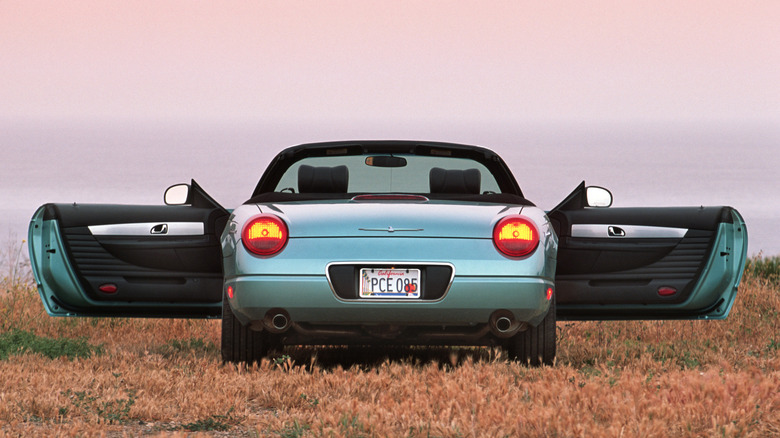Why Ford's T-Bird Retro Reboot Didn't Last Long
Ford may have exhibited too much hubris when, in 2002, it launched its eleventh-generation Thunderbird to much fanfare, only for it to prove a sales flop and completely finish off the T-Bird nameplate. Its arrival was announced by a 1999 North American Motor Show concept, which was just a thinly veiled production car that was well received by the automotive media of the time.
Its design was inspired by what is regarded as the best-looking Thunderbird, the 1955–1957 model, and it was touted as being a return to form for an iconic nameplate after decades of adorning sometimes lackluster T-bird-badged cars. Yet the model never struck a chord with buyers, and it sold around 68,000 units over its four-year production span.
It got off to a good start, selling over 31,000 units in its first year, but the figure dropped constantly until 2005, the vehicle's final year of production. Now, though, almost 20 years after it was unceremoniously taken out of production, we can more clearly see what the reasons behind its failure were and why it never became the heavy-hitter that Ford expected.
Retro Reboots Are a Gamble
Looking at other brands that, at about the same time, launched successful retro-inspired models (the Mini Cooper and the Volkswagen Beetle), it made sense for Ford to do the same. However, repurposing design cues from decades past in a new car can often lead to designs that may end up being called pastiche if they don't get the balance of retro and modern just right, and this could be what happened to the eleventh-gen T-Brid.
BMW's rebooted retro-infused Mini unapologetically took styling elements from the original, and many didn't like this nostalgia-heavy approach. However, it also drove brilliantly and not only met buyers' expectations of performance but actually exceeded them. It was so much fun to drive that even people who didn't like the way it looked still bought one to experience the famous go-kart-like handling.
The last T-bird leaned so heavily on nostalgia and the weight of the Thunderbird name that it may have pushed away buyers who wanted something more understated. There was also somewhat of a mismatch between the car's low-slung, sporty looks and the performance it could actually deliver.
Ford never saw the 2002 T-Bird as a performance car, which is why it was exclusively equipped with a Jaguar-sourced 3.9-liter V8 engine that officially produced just 252 horsepower and 267 pound-feet of torque, which Edmunds lists as making 280 horsepower. That was enough to make a swift cruiser out of it, but with a 0 to 60 mph sprint time of around seven seconds, it could never thrill in stock form.
It sent its power to the rear wheels through a five-speed automatic transmission that did a good job of making the car feel smooth, but it did nothing to boost the fun factor.
Ford Could Have Tried to Fix the T-Bird
Even though Thunderbirds weren't flying out of showrooms at anywhere near the rate Ford had predicted, the manufacturer didn't try to change or improve the vehicle significantly during its production run. Ford did offer a removable hardtop option in 2002, which featured distinctive-looking round port windows, but it wasn't enough to change the model's fortunes
Pricing could have also been adjusted to boost the model's appeal. The base price in 2002 was around $35,000, which rose to about $40,000 by 2005, and this positioned it against models like the Chevrolet Corvette, Mercedes-Benz SLK, and BMW Z4. They may not have been retro-styled, but they were two-seaters that were much more enjoyable to drive, and that seems to have been more attractive for buyers. For those with deeper pockets, the BMW Z8 was another alternative (which also had a design inspired by a 1950s classic).
Even though the eleventh-generation Thunderbird was not a small car, it offered limited practicality, so it didn't make for the best daily driver. The fact that it was a two-seater also limited its appeal, and it probably would have been a more successful model if Ford altered the original formula and turned it into a four-seater convertible.
The eleventh-gen T-Bird didn't last long because of a muddled focus, excessive leaning on nostalgia, not enough interest from Ford to improve the model, and the availability of other two-seaters that resonated more with buyers. There is still hope for the car, though. Since it is rare and has an interesting backstory, the Thunderbird could become a future classic in another few decades' time. As for the nameplate, there is a rumor that Ford could introduce a Thunderbird-badged EV, but so far the manufacturer has stayed mum on the matter.


